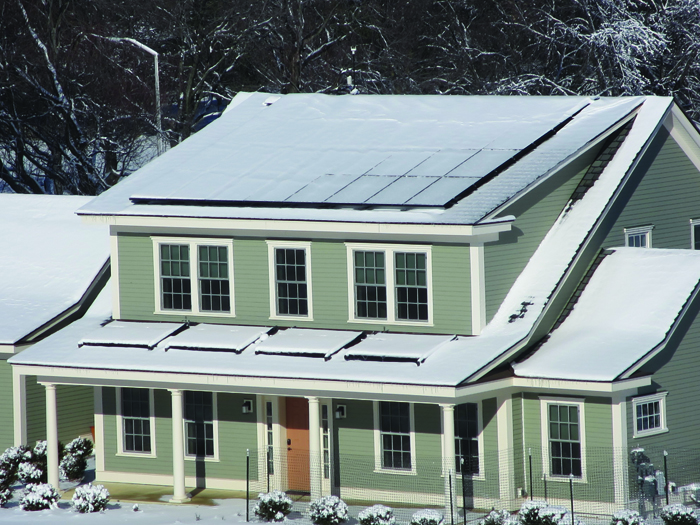Zero Energy Homes—With Help from Plastics
Trillions of BTU can be saved with advanced insulation and other plastics-aided innovations
Previous Article Next Article
By American Chemistry Council
Zero Energy Homes—With Help from Plastics
Trillions of BTU can be saved with advanced insulation and other plastics-aided innovations
Previous Article Next Article
By American Chemistry Council
Zero Energy Homes—With Help from Plastics
Trillions of BTU can be saved with advanced insulation and other plastics-aided innovations
Previous Article Next Article
By American Chemistry Council

The Net-Zero Energy Residential Test Facility sits on the campus of the U.S. National Institute of Standards and Technology (NIST) in Gaithersburg, Maryland. The laboratory was designed to demonstrate that a net-zero energy house—one that produces as much energy as it consumes over the course of a year—can fit into any neighborhood (photo courtesy of Beamie Young/NIST).

The Net-Zero Energy Residential Test Facility sits on the campus of the U.S. National Institute of Standards and Technology (NIST) in Gaithersburg, Maryland. The laboratory was designed to demonstrate that a net-zero energy house—one that produces as much energy as it consumes over the course of a year—can fit into any neighborhood (photo courtesy of Beamie Young/NIST).

Despite a harsh winter that left the Net-Zero Energy Residential Test Facility’s photovoltaic and solar thermal panels covered with snow on 38 days, the energy-efficient house produced more energy than it used over the course of a year (photo courtesy of NIST).

Despite a harsh winter that left the Net-Zero Energy Residential Test Facility’s photovoltaic and solar thermal panels covered with snow on 38 days, the energy-efficient house produced more energy than it used over the course of a year (photo courtesy of NIST).
Imagine a home that produces its own electricity. At times it may use some energy from the power grid, and at times it may give some back. But in the end, the give-and-take balances out. We actually do not have to imagine, because these homes already exist, and plastics play a fundamental role.
They are known as “zero energy homes.” Zero energy does not mean the homes use no energy for heating, cooling, and electricity. It simply means that the homes’ own energy generation is equal to the homes’ energy use. As noted, the homes at times may use energy from the community power grid and at other times may provide energy to the grid, but over time the homes are net energy neutral, which is why they sometimes are called “net-zero energy.”
Homes that actually generate more energy than they consume over time are called “positive energy” or “net-positive energy” homes. These homes now are a reality, through a combination of passive energy sources, such as solar and geothermal, and proper design with modern plastic foam insulation and other building products.
Wasted Energy
Nearly 40% of the USA’s energy is consumed in our homes and commercial buildings, and heating and cooling account for nearly half the energy use in U.S. homes, according to the U.S. Energy Information Administration (EIA). Unfortunately, much of this energy is wasted due to outdated building practices and construction. In addition, EIA estimates that six percent of energy is lost in transmission over power lines. Wasted energy not only hurts our environment, it also hits our wallets.
Therefore, zero energy homes can contribute significantly to our nation’s efforts to improve energy efficiency in two ways: by providing passive electricity on site and eliminating long-distance transmission power loss.
How do we know this really works? The National Institute of Standards and Technology (NIST) built a “Net-Zero Energy Residential Test Facility” near Washington, D.C., in 2013. On the facility’s one-year anniversary, NIST announced that the home had produced more energy than it used, enough to “power an electric car for about 1,440 miles.”
NIST found that “[i]nstead of paying almost $4400 for electricity—the estimated average annual bill for a comparable modern home in Maryland—the virtual family of four residing in the all-electric test house actually earned a credit by exporting the surplus energy to the local utility.” The house achieved this “[d]espite five months of below-average temperatures and twice the normal amount of snowfall.”
What Role Do Plastics Play?
Insulation obviously is key to reducing energy loss in any home, zero energy or not. While each building is unique, zero energy homes typically rely on modern plastic foam insulation systems under and around the foundation, in the walls, and in the roofing, which can dramatically decrease the amount of energy needed to heat and cool a home.
Many of these insulation products do not simply increase R-value, they also help reduce leaks and air loss to seal the building envelope. And these are not novel or unique insulation systems—they all are currently available to homebuilders, for example:
- Sheets of polystyrene foam under and around the home’s foundation create a barrier and insulate the floors and walls. Foundations are poured directly onto the insulation sheets, which also are attached to below-grade foundation walls.
- Insulated concrete forms (usually expanded PS forms that stack and are filled with concrete and rebar to create walls) provide excellent insulating properties and create a very solid building.
- Structural insulated panels typically sandwich large sheets of expanded PS foam between oriented strand board (OSB), creating large wall systems with few seams, greater R-value, and improved strength.
- Polyiso (polyisocyanurate) or polyurethane foam installed under the roof system, instead of in the attic floor, helps seal the building against leaks and helps increase the R-value of the roofing system. The NIST home used this method to achieve an R-value of 75 in its roofing system, which is about twice the typical R-value of area homes. In addition, because the attic is tempered space (heated and cooled), ductwork doesn’t shed its cool or hot air in un-tempered space.
- The NIST building used six-inch instead of four-inch studs in order to increase the space for insulation between studs, plus a plastic air moisture barrier and four inches of polyiso foam on the exterior, which virtually eliminated thermal bridging (the transfer of heat between the interior and exterior caused by non-insulating materials).
- While not used in all the above insulation systems, plastic house wrap significantly diminishes the infiltration of outside air, helping to reduce the energy required to heat or cool the home.
- Finally, plastic sealants (caulks, mastics, foams, tape) are applied to any remaining gaps that may exist between floors, walls, roofs, and windows, as well as around ductwork joints.
NIST estimates that its home is almost 70% more efficient than the average area home.
“The most important difference between this home and a Maryland code-compliant home is the improvement in the thermal envelope—the insulation and air barrier,” NIST mechanical engineer Mark Davis said in a news release. “By nearly eliminating the unintended air infiltration and doubling the insulation level in the walls and roof, the heating and cooling load was decreased dramatically.”
To actually reach zero energy, many other energy-saving products made with plastics can be used, such as plastic piping for radiant heat and efficient water delivery, insulated window frames clad in plastics, highly energy-efficient refrigerators, and even plastic roofing tiles that incorporate solar cells in the tiles themselves instead of having to install both tiles and panels. And like the insulation systems, all of these building products are in use right now.
So that’s what modern plastic foam insulation and building products can do for zero energy homes. How much do they contribute to energy efficiency of U.S. homes overall? A one-year study by Franklin Associates found that the use of plastic building and construction materials saved 467.2 trillion BTU (493.0 trillion kJ) of energy over alternative construction materials. That’s enough energy saved over the course of a year to meet the average annual energy needs of 4.6 million U.S. households.
The Future
While zero energy homes are still outside the norm, numerous events and trends are driving efforts to dramatically improve energy efficiency, such as concerns over climate change impacts and substantial upgrades in building codes.
To encourage greater energy efficiency, NIST plans “to develop tests and measurements that will help to improve the energy efficiency of the nation’s housing stock and support the development and adoption of cost-effective, net-zero energy designs and technologies, construction methods, and building codes.”
And according to NIST, some “states are taking steps toward encouraging or even requiring construction of net-zero energy homes in the future. For example, California will require that, as of 2020, all newly constructed homes must be net-zero energy ready.” That’s going to require a lot of help from plastics.

